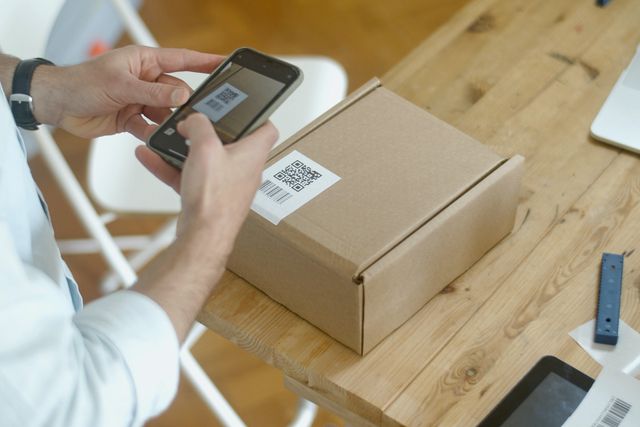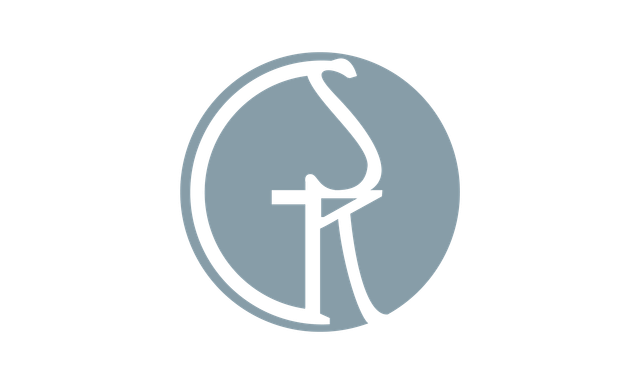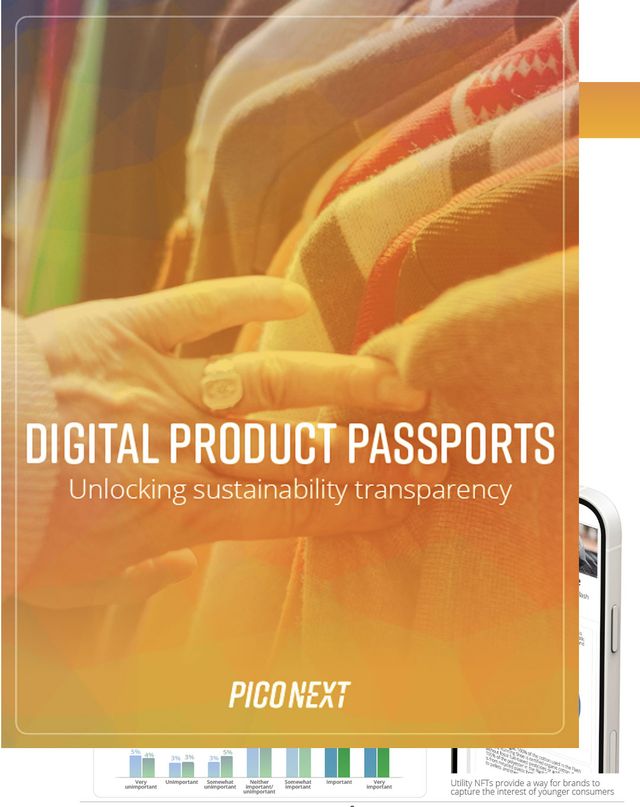What is a Digital Product Passport (DPP)?
A Digital Product Passport (DPP) is a tool that provides information about a product's sustainability.
When customers scan a QR code on a product, they can see details about it, like what kinds of materials are used, the carbon footprint, how to repair the product, how to recycle the product, and how it was manufactured.
Required for products in Europe
New rules in the European Union will require products to have Digital Product Passports. These rules will have businesses provide more details on how eco-friendly their goods are.
The main idea behind these regulations is to encourage a "circular economy". A circular economy is one where products are used, reused, and recycled, rather than a linear economy where products are used once and thrown away.
Providing more details about a product's sustainability also helps companies avoid "greenwashing". Greenwashing is when companies dishonestly say they are helping the environment to impress customers, but their actual impact is small.
Greenwashing makes customers trust brands less and brings negative media attention to their efforts.
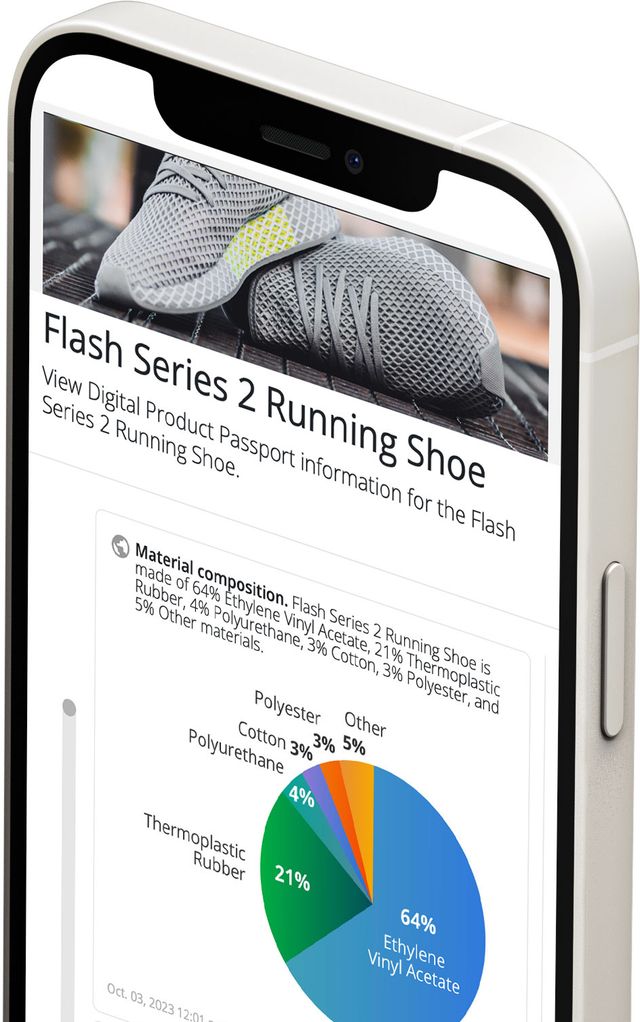
Creating a sustainable economy
The E.U. wants to require Digital Product Passports to help solve some of the sustainability problems it's facing. These sustainability problems include some of the following: [^1]
- Inefficient use of natural resources
- Poor environmental consequences
- Less reuse and recycling
- Negative social impacts
- Different approaches to sustainability in different countries
A Digital Product Passport allows different people in the supply chain, such as manufacturers, importers, retailers, repairers, and consumers, to access information about a product. One of the advantages of this information is that it is easily accessible and simple to use. This can assist these various stakeholders in deciding how to use, recycle, or dispose of different goods. The regulations for Digital Product Passports are still being formulated, but this guide can help you understand what a DPP is and how to prepare for its implementation in your business.
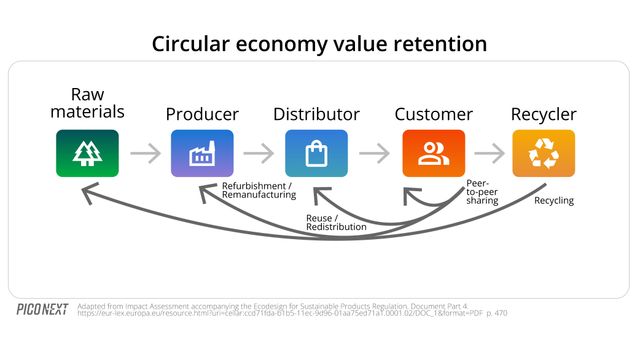
How does a Digital Product Passport enable a circular economy?
The concept of a circular economy is driving the European Union to mandate Digital Product Passports for specific industries. [^2] According to the E.U.'s Circular Economy Action Plan, a circular economy is “where the value of products, materials and resources is maintained in the economy for as long as possible, and the generation of waste minimised”. In simpler terms, products can be reused, repaired, and recycled to keep them functional, rather than simply discarding them.
A linear economy, in contrast, is characterized by a direct flow of goods through the economy. It begins with sourcing raw materials, transforming them into products, and then selling them at a store. The customer buys the product and, after use, disposes of it. Conversely, a circular economy emphasizes actions individuals can take to extend the usefulness of goods over time.
A crucial aspect of enhancing customer transparency regarding a product is providing accurate, reliable data about it. Gathering this data from various parties within the supply chain is often the most challenging aspect of preparing a Digital Product Passport. When customers have product data that is easy to understand, they can make informed decisions on which products to buy, as well as how to reuse and recycle the items.
Who is required to create one?
A part of the regulations in the European Union stipulates that the "economic operator" of a product must issue a Digital Product Passport. [^3] An economic operator typically refers to the manufacturer of a product. In some cases, it could also refer to the company that imports the product, a distributor, a dealer, or a fulfillment service provider. [^4]
What are the benefits?
Different groups can gain various advantages from increased transparency regarding their products. Consumers can compare different products based on sustainability when making purchase decisions. After acquiring a product, they can access additional information about it through a Digital Product Passport. This information may include care and usage instructions, repair details, and certificates of authenticity.
Companies that make products (manufacturers) can provide proof of sustainability claims. They can also gain more information about how customers are using the products. If a product turns out to have a problem, they can also better communicate with customers about recalls or repairs.
There are numerous ways that different groups can benefit from Digital Product Passports. The chart below summarizes some of these benefits:[^5]
| Group | Benefits |
|---|---|
| Raw material supplier |
|
| Manufacturer |
|
| Retailer |
|
| Consumer |
|
| Repairer |
|
| Recycler |
|
How do DPPs enhance the business case for sustainability?
People are generally feeling positive about Digital Product Passports. The European Commission conducted a survey to gauge people’s thoughts on this idea, alongside other sustainability regulations. More than half of the 626 individuals who responded to the survey were from businesses. Additionally, 68% of these business respondents believe they should provide details about environmental impact in a Digital Product Passport.
Most individuals, including consumers and environmental organizations, want a Digital Product Passport to include information regarding a product's environmental impact, as well as social initiatives. This encompasses details about how a product is manufactured, such as whether workers were treated fairly and if child labour was involved. A significant majority of consumers and environmental groups feel it is essential for companies to disclose this information in the passport. 88% of consumers supported the inclusion of environmental information, while 85% desired social impact information. Environmental groups were even more supportive, with 92% advocating for environmental information and 90% for social information.
According to other surveys, implementing sustainability programs makes business sense. When it comes to purchasing decisions, consumers are two to three times more likely to choose the most sustainable product option if all other factors are equal. Moreover, these consumers are willing to buy an eco-friendly product, even if it comes at a slightly higher price.
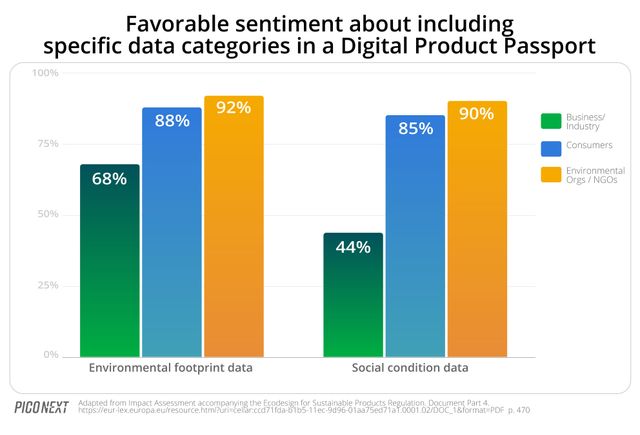
What data do customers want to see in a DPP?
Recently, we conducted original research on Digital Product Passports with over 1000 individuals to determine what kind of sustainability information they would like to see. The results indicate that they appreciate the concept of a DPP, and focus on specific areas where they could benefit from this information.
When customers can readily find out how sustainable a product is through a Digital Product Passport, they are more likely to trust the brand and wish to purchase its products. Our study found that 73% of individuals feel more confident in a brand when they can access detailed sustainability information. Additionally, 67% of respondents stated they would be more inclined to buy a product if they had access to such information.
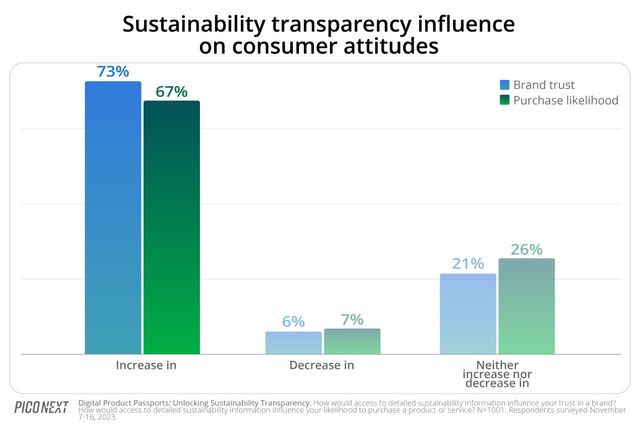
Top expectations for transparency: Recyclability and materials composition
The most important thing customers want to know about when buying a product is if it can be recycled, according to our survey. More than half of the people surveyed (56.1%) said that understanding recyclability makes them more likely to buy. Other important things for customers are knowing what materials are used (44.4%), ensuring that child labour was not involved (39.6%), and efforts to reduce waste (39.0%).
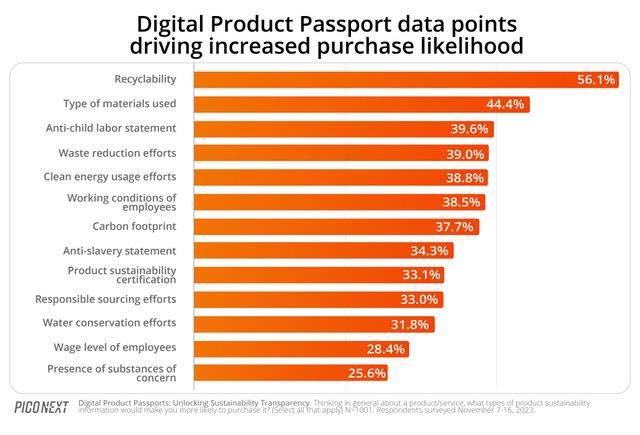
Consumers want to verify authenticity and sustainability claims
Customers are also asking companies to share more about how they are helping the environment. They want to know if the products are authentic (34.7%), to know if the products are really made in a sustainable way (33.7%), and to find out where they can recycle the goods (33.7%).
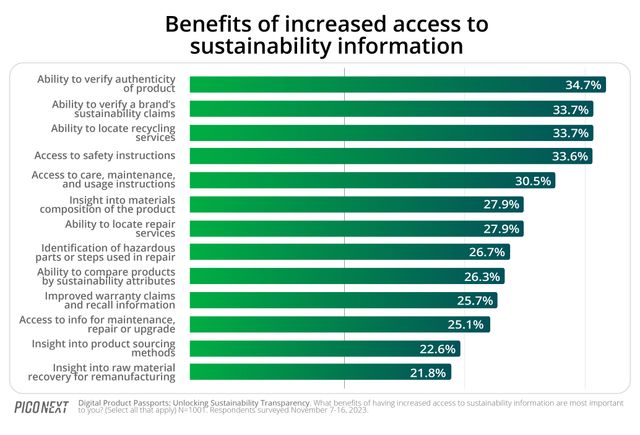
See all data and infographics in the full report
Preventing greenwashing
One important reason to have a Digital Product Passport is to prevent “greenwashing”. Greenwashing is when companies falsely claim to be environmentally friendly in their marketing to attract consumers, particularly younger ones like Millennials and Generation Z. It's a problem because these companies might not actually be helping the environment despite what they say. A DPP provides evidence that a company is doing what it says. When customers see that they're backing their words with action, they can trust the brand more.
Some companies have been hit with negative publicity about greenwashing. Delta Air Lines was served a class action lawsuit alleging that its carbon neutral claims were bogus. Evian Natural Spring Water faced a similar lawsuit about its carbon credits. And the maker of Nivea skin care products, French energy company TotalEnergies, and Dutch airline KLM, have all faced legal action over their net-zero claims. Even FIFA, the international soccer federation, had negative press about their statements.
Companies can prevent greenwashing by using a Digital Product Passport. This tool helps customers see that what a company is saying about sustainability is backed up with evidence. Different people and groups can track a product's sustainability throughout its lifecycle, confirming if the brand's sustainability statements are genuine.
What is the E.U. DPP legislation?
The European Union rules that create the DPP concept have been worked on for a long time. They build upon several other environmental programs that the E.U. has worked on in recent years, including:
- The Ecodesign Directive - A 2009 law that regulates the design of energy-related products
- The Circular Economy Action Plan - A set of actions adopted in 2015 to transition the European economy from linear to circular
- European Commission’s 2020 Industrial Strategy - Lays out the vision for a ‘twin transition’ to climate neutrality and digital leadership
- The European Green Deal - A policy initiative approved in 2020 with the goal of making the E.U. carbon neutral by 2050
The European Union introduced a new proposal in March 2022 to combine different efforts that worked towards sustainability. The new rules expand on the 2009 Ecodesign Directive. Previously, this Ecodesign Directive only controlled products related to energy. Now, the expanded legislation, known as the Ecodesign for Sustainable Products Regulation (ESPR), covers a broader range of items. It introduces the idea of a Digital Product Passport and plans for more detailed rules for different types of products in the future. These additional rules are called "delegated acts" and will be specific to individual industries. The E.U. expects to have 18 additional delegated acts during 2024-2027 that companies will need to comply with.
Which industries need to implement a DPP?
Some industries are expected to require Digital Product Passports, based on how they align with a circular economy. The industries that are expected to require a Digital Product Passport include those outlined below. The first industry-specific rules have already been launched for batteries. Many people see this E.U. Battery Regulation as a preview of how rules will unfold for other industries.
| Industries targeted for Digital Product Passport | Digital Product Passport not Required |
|---|---|
|
|
What is the timeline to implement?
The Ecodesign for Sustainable Products Regulation plans to create specific rules for different industries on how they can use Digital Product Passports.
| Industry | Implementation date | Products affected | Source |
|---|---|---|---|
| Batteries | 18 February 2027 | LMT batteries, Industrial batteries with a capacity greater than 2 kWh, Electric Vehicle batteries | E.U. New Batteries Regulation, Article 77 ["^11"] |
| Fashion / Textiles | DPP regulations in process during 2023-2027 | General textiles | E.U. Strategy for Sustainable and Circular Textiles, Sec. 2.4, also, ESPR Sec. 4 ["^12"] |
| Electronics, Plastics, Furniture, Chemicals | DPP regulations in process during 2023-2027 | General electronics | Eco-design for Sustainable Products Regulation (ESPR) Sec. 4 ["^12"] |
| Construction products | DPP regulations in process during 2023-2027 | General construction products | Construction Products Regulation, also through ESPR ["^13"] |
What are the requirements?
The Ecodesign for Sustainable Products Regulation (ESPR) outlines the DPP concept, as well as some guidelines on what passports should contain. According to the proposal, the DPPs should be:["^14"]
- Interoperable with each other
- Long-lasting, even if a company runs out of funds
- Able to preserve data authentication, reliability, and integrity
- Secure and privacy-compliant
- Traceable across the value chain
- Based on open standards
- Machine readable
The ESPR does not set specific rules for the Digital Product Passport. It expects future laws (the delegated acts) to outline industry-specific requirements for different sectors. These laws will cover details like:
- Product attributes. The product details to be included in the passport
- Data carrier. How a customer can access the DPP, whether it's through a QR code, RFID tag, or something else
- Product scope level. The level at which the DPP is applied to the product: to the product model, to product batches, or to individual product items
- Data access. How passport data should be accessed (publicly, or role-based)
See a demo of Digital Product Passports
Data carrier
A "data carrier" helps someone get access to the DPP. It is usually provided on the product itself (like on a hangtag, engraved on the item, or on a sticker). It could also be accessed on documentation or manuals that come along with the product.
The E.U. mentions some kinds of data carriers, like the following ones. Each product group will have data carriers based on the additional rulemaking over the next several years.[^15]
- QR code. A QR code is a two-dimensional matrix code that is scannable by smartphones. It is familiar to consumers and easy to produce. A QR code can open a Web page that contains Digital Product Passport information.
- Barcode. A one-dimensional barcode is cheap to produce but can trigger errors based on the quality of printing.
- Radio frequency ID (RFID). RFID tags are more expensive to use but can contain more data - from 2 to 128 kilobytes. They are useful for machine sorting and require a special scanner to use.
- Watermark. A watermark is a nearly invisible tag applied to a product. They can contain specialized types of data. They are secure and not easily replicated but require special scanners to be read.
|
|
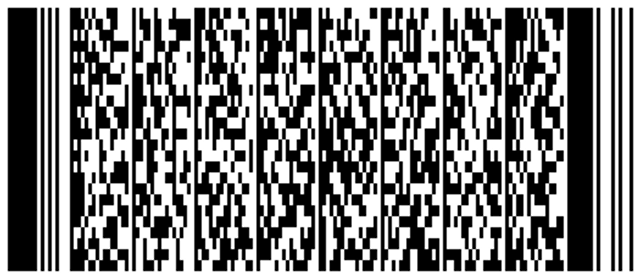 |
 |
 |
| QR Code | Barcode | RFID | Watermark |
Out of these choices, QR codes are very common and simple for companies to make. People are generally familiar with how to use their smartphones to scan QR codes and open Web pages that provide them information, like Digital Product Passport data.
Product scope level
The ESPR rules say that a Digital Product Passport can be applied to a product model, a product batch, or an individual product item. The additional rules that will come in the next few years will determine which scope is appropriate for each product group.
 |
 |
 |
|
Product Model
All the items of a specific product
|
Product Batch
A group of products sharing a manufacturing batch number
|
Product Item
An individual product item
|
One note, as a DPP is applied to individual items, it becomes more challenging to coordinate the data for that product and link it with the DPP.
Product attributes
The ESPR proposal states that providing comprehensive data about products can assist individuals in making better decisions. As the DPP rules become more intricate for various types of products, they will likely include more specific requirements. The E.U. Batteries Regulation, for example, enumerates specific technical data that battery manufacturers should incorporate into a DPP. The categories below can serve as a foundation for what information to include in a Digital Product Passport, along with any required details specified in a particular rule.
Durability and reliability of the product or its components, including
- Guaranteed lifetime
- Technical lifetime
- Mean time between failures
- Indication of real use information on the product
- Resistance to stresses or aging mechanisms
Quantity, characteristics and availability of consumables needed for proper use and maintenance
Options and incorporation of used components
Ease of upgrading
Ease of repair and maintenance as expressed through:
- Characteristics, availability and delivery time of spare parts
- Modularity
- Compatibility with commonly available spare parts
- Availability of repair and maintenance instructions
- Number of materials and components used
- Use of standard components
- Use of component and material coding standards for the identification of components and materials
- Number and complexity of processes and tools needed
- Ease of non-destructive disassembly and re-assembly
- Conditions for access to product data
- Conditions for access to or use of hardware and software needed
Re-use, remanufacturing, and refurbishment as expressed through:
- Number of materials and components used
- Use of standard components
- Use of component and material coding standards for the identification of components and materials
- Number and complexity of processes and tools needed
- Ease of non-destructive disassembly and re-assembly
- Conditions for access to product data
- Conditions for access to or use of hardware and software needed
- Conditions of access to test protocols or not commonly available testing equipment
- Availability of guarantees specific to remanufactured or refurbished products
- Conditions for access to or use of technologies protected by intellectual property rights
- Modularity
Use of substances, either on their own, as constituents of substances, or in mixtures, during the production process of products, or leading to their presence in products, including once these products become waste
Consumption of energy, water, and other resources in one or more life cycle stages of the product, including the effect of physical factors or software and firmware updates on product efficiency and including the impact on deforestation
Use or content of recycled materials
- Possibility of remanufacturing or recycling
- Ease and quality of recycling as expressed through:
Avoidance of technical solutions detrimental to re-use, upgrading, repair, maintenance, refurbishment, remanufacturing, and recycling of products and components
The environmental footprint of the product, expressed as a quantification, in accordance with the applicable delegated act, of a product’s life cycle environmental impacts, whether in relation to one or more environmental impact categories or an aggregated set of impact categories
Emissions to air, water or soil released in one or more life cycle stages of the product
Weight and volume of the product and its packaging, and the product-to-packaging relation
- Microplastic release
- Amounts of waste generated, including plastic waste and packaging waste and their ease of re-use, and amounts of hazardous waste generated
Data storage: Blockchain vs. cloud
The ESPR legislation enables a central registry to monitor special product ID numbers linked to a Digital Product Passport, but allows companies the flexibility to determine where to store the actual data. This structure ensures that the DPP can adapt easily to business trends and innovations. It keeps DPPs “flexible, agile, market-driven, and evolving in line with business models, markets, and innovation.”
Companies can opt for centralized (server-based in the cloud) or decentralized (blockchain) data storage solutions. Each of these data storage methods comes with its own set of strengths and weaknesses.
Cloud
In centralized models, product data is stored in a database that users can access through the cloud. Pricing and usage models are widely understood, but the transparency of the data may not be easily verifiable.
Moreover, there exists a risk of security breaches where hackers could infiltrate the database, or network outages that could disrupt access. If a company ceases operations, it is unclear how the data will be preserved as mandated by law, particularly since the company might not be able to finance further data storage. If a technology provider shuts down or is acquired by a firm with differing strategies, data storage could become precarious.
Blockchain
Decentralized, blockchain-based models provide an alternative to cloud-based models. In a blockchain model, data is recorded on a public ledger and cryptographically confirmed on the blockchain. Once entered into a blockchain, it is immutable and cannot be changed. It provides confidence that the data is secure and valid. Data on a blockchain is traceable, allowing people to view what product attributes were added by whom, and when.
Blockchain technology stores data in a decentralized way, spreading it across many connected computers. This helps ensure the data is reliable and reduces the risk of network issues. Another benefit is that information stored on a blockchain stays there permanently. Even if the company that first stored the data goes out of business, the data will still be accessible since it's duplicated on different computers. This feature is especially useful for following these new E.U. DPP rules.
| Centralized storage (cloud) | Decentralized storage (blockchain) |
|---|---|
|
|
Social impact attributes
Social impact reporting is not currently required. The E.U. has stated that it could re-visit the inclusion of social-related data eight years after the ESPR is officially written into law. Social impact programs are popular among customers, with 85 percent of European consumers having a favorable opinion of seeing this kind of data in a DPP.
In addition, Generation Z consumers, born between 1990 and 2010, care a lot about social and environmental issues. They prefer to purchase products from companies that align with their values. They believe that businesses possess the capability to effect positive change in society and they prefer to support companies that champion causes they are passionate about.
They expect businesses to use the resources available to them responsibly. They also desire companies to create products that are advantageous and beneficial to society. With a buying power of $360 billion, Generation Z has the capacity to influence how brands engage with them through sustainability and socially-conscious actions. As a result, companies should contemplate incorporating social impact reporting in their Digital Product Passport, which should include:
- Donations to causes aligned with the company (e.g. reforestation, carbon removal, community programs)
- Other involvement with causes (e.g. employee volunteering, mentorships)
- Employment safety disclosure and audit
- Fair wage disclosures and verification
- Fair labor certifications
- Employee working hours and conditions
- Employee safety and accident reporting
- Absence of child labor reporting and verification
Are blockchains sustainable and can they be used for DPPs?
Historically, blockchains consumed a significant amount of resources, but currently, they are adopting more sustainable practices. A new technology in Ethereum-based blockchains, introduced in 2022, has addressed concerns regarding energy consumption.
The innovative method these networks use to confirm transactions, termed proof-of-stake, substantially diminishes the electricity consumption of the blockchain network. This technique reduces annual electricity consumption by nearly 99.988% and decreases the network's carbon footprint by approximately 99.992%, according to Ethereum.org. Other blockchains, such as the Polygon network, are not only eliminating all the network's carbon debt since their inception but are also establishing a process to become carbon-negative in the future.
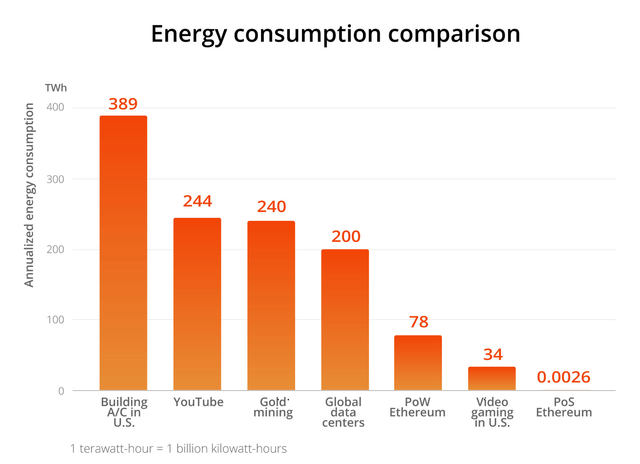
Listen to a podcast about What is a Digital Product Passport?
What are Digital Product Passport examples?
Brands have begun launching examples of Digital Product Passports to engage with their customers and showcase their dedication to sustainability.
Bon+Berg: Turnkey blockchain DPP
Bon+Berg is a company from Dublin, Ireland that creates eco-friendly women’s undergarments. It makes bras and bottoms using sustainable practices throughout their production process. The company promotes slow fashion and avoids greenwashing.
Bon+Berg uses PicoNext and the eco-friendly Polygon blockchain to securely store its sustainability information on a public record. This helps track data changes and ensures they stay accessible. To make information accessible quickly, the brand used a ready-made DPP viewer from PicoNext to display sustainability data from the public ledger.
The Morphbag by GSK: Cloud-based DPP
The Morphbag, a fashion brand in London, makes vegan-leather bags like totes, handbags, and clutches for busy and fashionable women. They have certifications for their vegan products. They also audit their factories and plant trees in the Amazon rainforest for every handbag set sold.
The Morphbag created a cloud-based DPP in order to update sustainability attributes in its passport as its supply chain strategy evolves. With this setup, it has the option to use a blockchain-based solution in the future too. A pre-built, web-based DPP viewer renders and displays sustainability data from the cloud, without customers needing to download or install any additional apps.
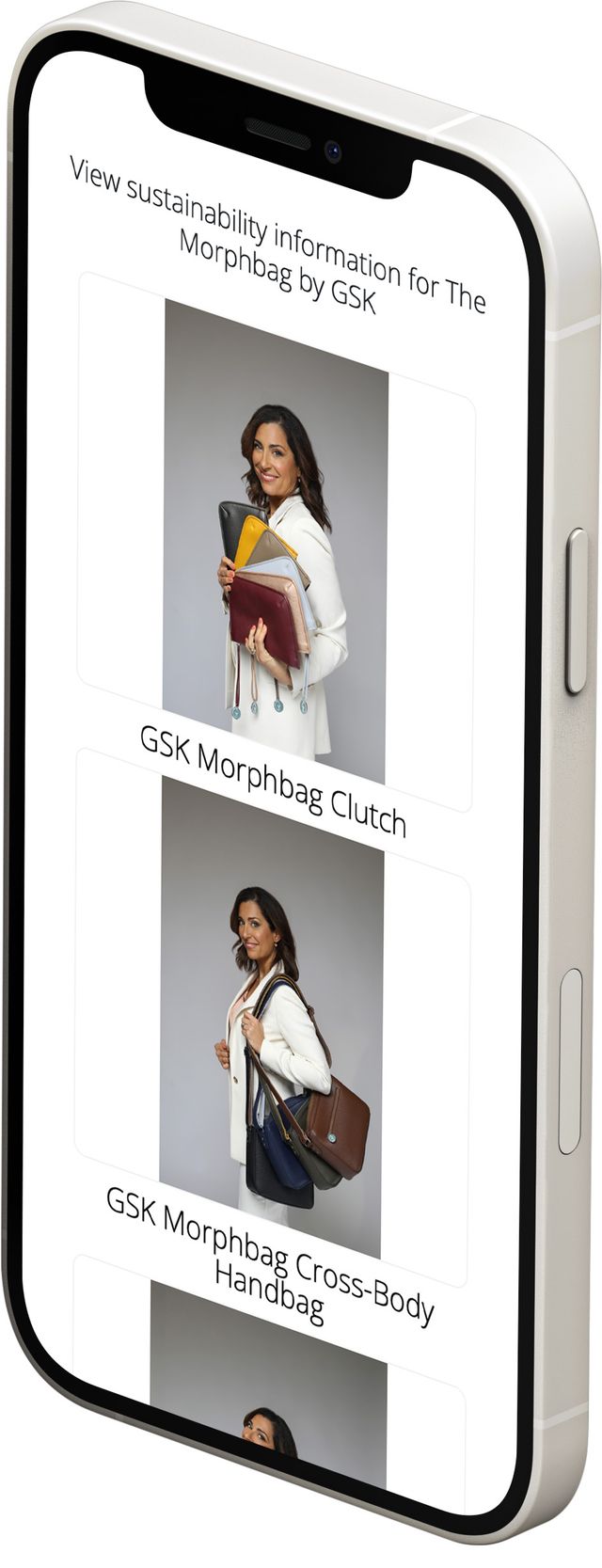
Simple Chic: Custom-branded DPP
Simple Chic is a women's clothing brand based in Sydney, Australia. It offers custom-made women's clothes made by local designers using natural materials. They also provide services to recycle clothes before and after you purchase them.
Simple Chic created a custom-branded DPP and makes it easily available for customers through a QR Code. With a custom-branded DPP, Simple Chic could retain full control over the brand and customer experience, ensuring that it complied with brand and sustainability guidelines.
Tammam: Product transparency with blockchain DPP
Tammam is a couture fashion studio in London, England with a commitment to environmental and social responsibility. Its recent collaboration with the European Space Agency (ESA) features prints of landscapes affected by climate change through satellite imagery on its high-end scarves.
Tammam’s DPP is on a public-ledger and traces the "fiber-to-finish" philosophy of its sourcing and production process for its new ESA scarves collection.

Authenticating products
Digital Product Passports can help brands and customers by making it easier to know if a product is genuine. By using a DPP to track a product's materials and how it was made, brands can see where the product originated. When brands assign each product its own DPP on a public ledger (blockchain), they can verify that the product is truly from their company. Verifying product authenticity, in fact, ranked highest among the benefits that consumers expect to gain from Digital Product Passports in our survey of over 1000 consumers.
When product information is saved on a blockchain, it is secure, immutable, and trackable. This enables people to know where a product comes from. Unlike paper or PDF certificates, customers viewing product information on a blockchain can trace each component of the product — such as where the materials originated, how it was designed, how it was produced, and more. This helps individuals understand the product's origins better and gives consumers more confidence that they are purchasing a legitimate product. In this way, companies can more effectively combat counterfeit goods.
How can brands create a customer experience?
Digital Product Passports may initially seem like something for supply chain managers, but companies should also consider how to use them to enhance the customer experience.
This customer interaction can be vital in providing brand content that fosters lasting customer loyalty. For instance, in addition to product documentation included with a DPP, consider incorporating inspirational brand content that helps customers envision how the product fits into their lifestyle.
This point of contact can be used to showcase other offerings that could enhance the product and generate more revenue. For example, you might offer service or maintenance plans, suggest additional products to purchase, or recommend rental or leasing options.
Blockchain-based DPPs provide new avenues to engage with customers. Individuals with a tokenized Digital Product Passport are recognized as product owners and may receive special benefits, exclusive offers, and access that others without this passport or those using centralized cloud storage cannot obtain.
Loyalty offers. Brands can provide special perks, rewards, offers, and discounts to a tokenized DPP. These may include complimentary products, service plans, discounts on future purchases, or unique customer experiences. To access these perks, customers first verify that they possess the correct token, after which they receive a QR code or coupon code to redeem the reward. These rewards can be delivered to the end-customer over time, offering value to the customer and ensuring their loyalty.
Access Passes. Access Passes offer a collection of rewards and benefits for the customer, either from the brand itself or from associated partners. Similar to the loyalty benefits, customers verify their token and then are given a QR code to access their reward.
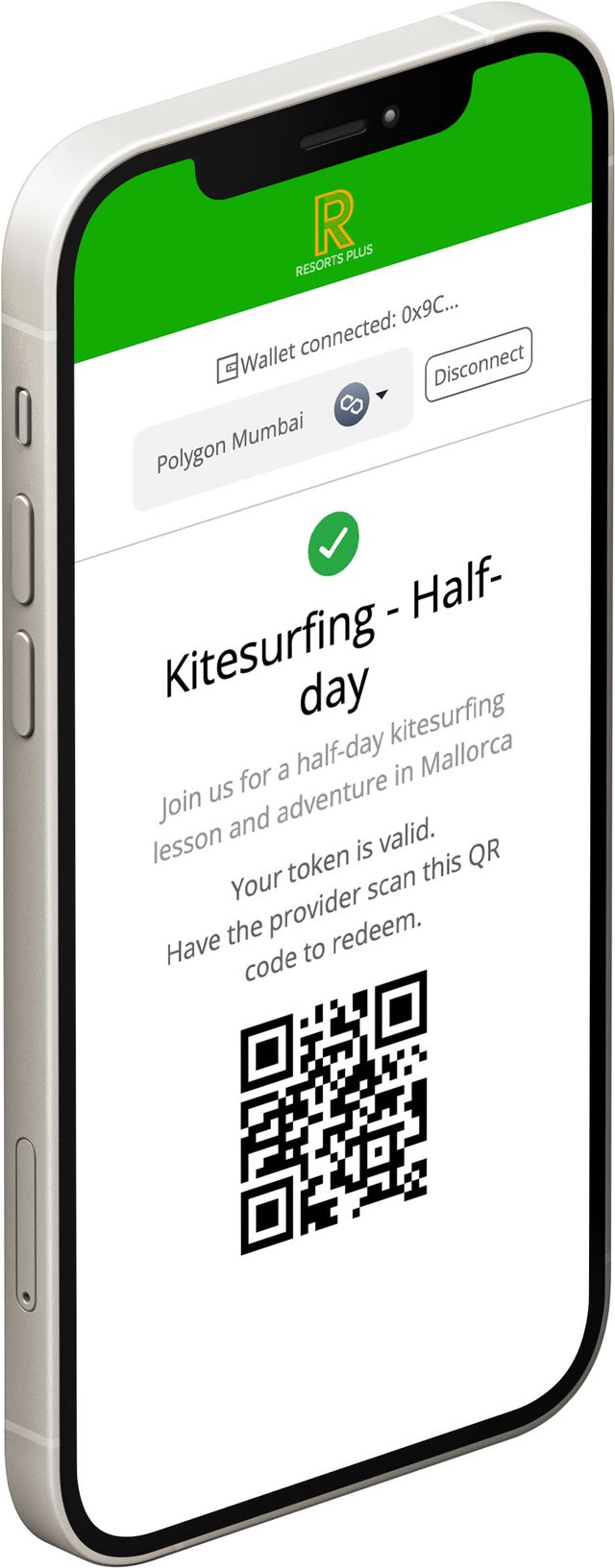
Token-gated content. Holders of blockchain DPPs can present their token to access exclusive brand content and user communities. This content may include how-to content, tips and tricks, Q&A sessions with product managers, and other valuable information.
Events. A public ledger DPP can also serve as an admission ticket to a digital or in-person brand event. Customers verify that they hold the correct token through a straightforward website, after which they receive a QR code that admits them to an in-person event or an access code for a digital event.
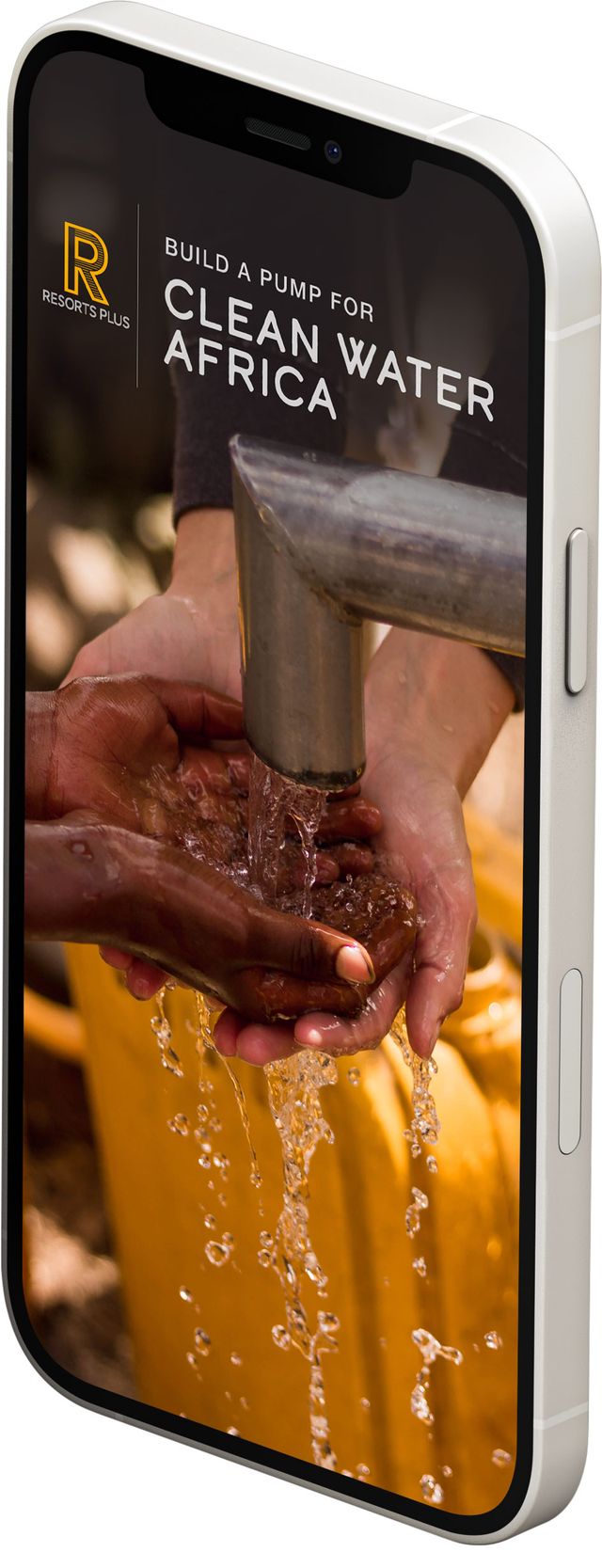
Social Impact. One of the advantages of a blockchain is that tokens and their related actions are governed by a set of rules encapsulated in a “smart contract.” These rules can be programmed to yield social impact benefits as part of a brand marketing program. For instance, customers who access a DPP or complete an action using it (such as product registration) may trigger a blockchain donation to an associated non-profit or charity. A manufacturer of swimwear, in this scenario, may include a donation to a coral reef restoration non-profit – thus aligning both the product’s purpose and the company’s brand story.
Carbon Offset / Carbon Removal Transparency. For businesses involved in carbon offset or carbon removal programs as part of their sustainability strategy, blockchain-based programs can provide transparency into the supply chain for these initiatives, verifying the actions taken towards achieving carbon neutrality. A blockchain can ensure that participants in the carbon offset / carbon removal program are fulfilling their commitments, giving assurance to the end-customer that their purchase is genuine.
Should U.S. and global companies think about DPPs?
Supply chains are increasingly global and interconnected. The E.U. Digital Product Passport legislation specifically applies to companies that launch products into the E.U. market. However, the sustainability standard it sets promises to influence non-E.U. companies as well.
Businesses should consider using DPPs now to ensure their products meet the required standards when working with suppliers and vendors worldwide. Following this model will also help companies be ready to enter the E.U. market in the future, giving them an advantage over their competitors.
GDPR: An example of E.U. legislation influencing other parts of the world
One recent example is the General Data Protection Regulation (GDPR) that was introduced in 2018. This law sets rules regarding how data should be protected and kept private for individuals within the European Union. Even though it’s designed for the E.U., many companies globally choose to adhere to these rules. Moreover, these regulations also influence other national and state laws, such as the California Consumer Privacy Act. One clear example of this influence is the common 'Accept Cookies' notifications that appear on websites now, even if they primarily do not operate in Europe.
What is the penalty for not complying with these regulations?
In the European Union, companies can face penalties for failing to comply with DPP rules. The ESPR legislation allows E.U. member states to establish penalties that are "effective, proportionate and dissuasive". Countries can also take into account the extent of non-compliance, as well as the number of affected product units.
How can companies roll out DPPs in a strategic way?
Companies should start preparing to implement DPPs. To gain internal support, obtain customer feedback, and test pilot projects, consider a three-phase model for implementation.
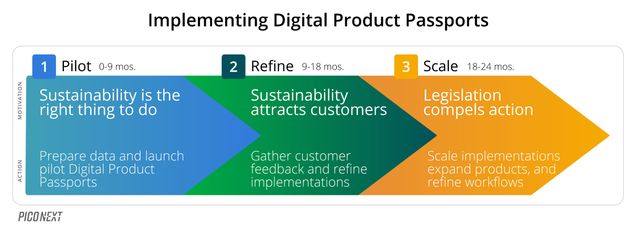
1 - Pilot. First, prepare for Digital Product Passports because it’s the right thing to do from a sustainability and social perspective. In this phase, focus on identifying pilot products, collecting product data, and tokenizing a few Digital Product Passports. Once the pilot projects are launched, assess how the sustainability messaging resonates with your customers, employees, investors, and other key stakeholders.
2 - Refine. Next, implement Digital Product Passports with the aim to better engage Millennial and Gen Z audiences. These younger demographics value companies that align with their principles, and high on their list are those brands that promote sustainability and social impact.
With your pilot Digital Product Passports launched, add a customer experience layer to engage users as they access your passport. In this phase, continue to test and refine your pilot Digital Product Passports to ensure a cohesive experience for customers.
3 - Scale. In the final phase, scale Digital Product Passport implementation in anticipation of impending E.U. legislation. Or, if in a non-E.U. country, finalize implementation in anticipation of the eventuality of fast-follower legislation, such as the California Consumer Privacy Act, which followed after the European Union’s GDPR. In the prior phases, you’ve initiated pilots, tested them with customer groups, and refined their implementation.
In this phase, expand the products you’ve included in your Digital Product Passport portfolio, by integrating with your product information management system or other enterprise workflow software. Continue to monitor usage, and use the Digital Product Passport touchpoint as a brand marketing touchpoint to communicate with your customers. Finally, plan for data assurance and governance by outlining audit workflows to ensure that your product attribute data is high-quality and accurate.
Using this three-phased approach, companies can develop internal learnings around their Digital Product Passport implementations to not only make sure they’re compliant with forthcoming legislation, but also to do the right thing in terms of environmental sustainability.
Get started
For more information on Digital Product Passports, see a demo of PicoNext.
See a demo of a Digital Product Passport
Impact Assessment accompanying the Ecodesign for Sustainable Products Regulation Document part 1. eur-lex.europa.eu/resource.html?uri=cellar:ccd71fda-b1b5-11ec-9d96-01aa75ed71a1.0001.02/DOC_1&format=PDF pg. 8-9 Impact Assessment accompanying the Ecodesign for Sustainable Products Regulation Document part 4. eur-lex.europa.eu/resource.html?uri=cellar:ccd71fda-b1b5-11ec-9d96-01aa75ed71a1.0001.02/DOC_4&format=PDF pg. 592 Product passport registry eur-lex.europa.eu/resource.html?uri=cellar:bb8539b7-b1b5-11ec-9d96-01aa75ed71a1.0001.02/DOC_1&format=PDF p. 57 Definitions eur-lex.europa.eu/resource.html?uri=cellar:bb8539b7-b1b5-11ec-9d96-01aa75ed71a1.0001.02/DOC_1&format=PDF p. 46 Impact Assessment accompanying the Ecodesign for Sustainable Products Regulation pg. 584-587 Impact Assessment accompanying the Ecodesign for Sustainable Products Regulation Document part 2. eur-lex.europa.eu/resource.html?uri=cellar:ccd71fda-b1b5-11ec-9d96-01aa75ed71a1.0001.02/DOC_2&format=PDF pg. 86-91 Impact Assessment accompanying the Ecodesign for Sustainable Products Regulation Document part 4. eur-lex.europa.eu/resource.html?uri=cellar:ccd71fda-b1b5-11ec-9d96-01aa75ed71a1.0001.02/DOC_4&format=PDF pg. 319 “Consistency with Other Union Policies” Ecodesign for Sustainable Products Regulation eur-lex.europa.eu/resource.html?uri=cellar:bb8539b7-b1b5-11ec-9d96-01aa75ed71a1.0001.02/DOC_1&format=PDF p. 3-4 “Enabling circularity through transparency: Introducing the EU Digital Product Passport” World Business Council for Sustainable Development and Boston Consulting Group wbcsd.org/contentwbc/download/15585/226483/1 p. 16 "New EU Ecodesign law – 'Making sustainable products the norm' or empty shell?" Squire Patton Boggs freshlawblog.com/2022/04/18/new-eu-ecodesign-law-making-sustainable-products-the-norm-or-empty-shell/. 18 April 2022. New Batteries Regulation. Regulation (EU) 2023/1542 of the European Parliament and of the Council of 12 July 2023 concerning batteries and waste batteries. eur-lex.europa.eu/eli/reg/2023/1542/oj EU Strategy for Sustainable and Circular Textiles. eur-lex.europa.eu/legal-content/EN/TXT/?uri=CELEX%3A52022DC0141, Eco-design for Sustainable Products Regulation (ESPR) eur-lex.europa.eu/legal-content/EN/TXT/?uri=COM%3A2022%3A0142%3AFIN Construction Products Regulation. eur-lex.europa.eu/legal-content/EN/TXT/?uri=CELEX%3A02011R0305-20210716, Eco-design for Sustainable Products Regulation (ESPR) eur-lex.europa.eu/legal-content/EN/TXT/?uri=COM%3A2022%3A0142%3AFIN Article 10 “Technical design and operation of the product passport” Ecodesign for Sustainable Products Regulation. eur-lex.europa.eu/resource.html?uri=cellar:bb8539b7-b1b5-11ec-9d96-01aa75ed71a1.0001.02/DOC_1&format=PDF p. 55-56 Impact Assessment accompanying the Ecodesign for Sustainable Products Regulation Document part 4. eur-lex.europa.eu/resource.html?uri=cellar:ccd71fda-b1b5-11ec-9d96-01aa75ed71a1.0001.02/DOC_4&format=PDF pg. 609 Article 1. “Subject matter and scope” Ecodesign for Sustainable Products Regulation. eur-lex.europa.eu/resource.html?uri=cellar:bb8539b7-b1b5-11ec-9d96-01aa75ed71a1.0001.02/DOC_1&format=PDF p. 42-43 Annex I. “Product parameters” Ecodesign for Sustainable Products Regulation – Annexes. eur-lex.europa.eu/resource.html?uri=cellar:bb8539b7-b1b5-11ec-9d96-01aa75ed71a1.0001.02/DOC_2&format=PDF p. 1-2 Clause 32. Ecodesign for Sustainable Products Regulation. eur-lex.europa.eu/resource.html?uri=cellar:bb8539b7-b1b5-11ec-9d96-01aa75ed71a1.0001.02/DOC_1&format=PDF p. 26 Explanatory Memorandum: Section 3 - Impact assessment. Ecodesign for Sustainable Products Regulation (ESPR). eur-lex.europa.eu/legal-content/EN/TXT/?uri=COM%3A2022%3A0142%3AFIN Impact Assessment accompanying the Ecodesign for Sustainable Products Regulation Document part 2. eur-lex.europa.eu/resource.html?uri=cellar:ccd71fda-b1b5-11ec-9d96-01aa75ed71a1.0001.02/DOC_2&format=PDF pg. 86-91 2023 Gen Z and Millennial Survey. 12th ed. Deloitte. deloitte.com/global/en/issues/work/content/genzmillennialsurvey.html "Gen Z Has $360 Billion to Spend, Trick Is Getting Them to Buy" Bloomberg. November 17, 2021. bloomberg.com/news/articles/2021-11-17/gen-z-has-360-billion-to-spend-trick-is-getting-them-to-buy “Ethereum's energy expenditure” Ethereum.org. ethereum.org/en/energy-consumption/ 31 August 2023 "Polygon Is Going Carbon Negative in 2022 With a $20 Million Pledge" Polygon Labs. polygon.technology/blog/polygon-is-going-carbon-negative-in-2022-with-a-20-million-pledge 12 April 2022 Article 10. "Technical design and operation of the product passport" Ecodesign for Sustainable Products Regulation. eur-lex.europa.eu/resource.html?uri=cellar:bb8539b7-b1b5-11ec-9d96-01aa75ed71a1.0001.02/DOC_1&format=PDF p. 55-56 "California’s new data privacy law brings U.S. closer to GDPR". TechCrunch. Dimitri Sirota. techcrunch.com/2019/11/14/californias-new-data-privacy-law-brings-u-s-closer-to-gdpr/ 14 November 2019 Penalties eur-lex.europa.eu/resource.html?uri=cellar:bb8539b7-b1b5-11ec-9d96-01aa75ed71a1.0001.02/DOC_1&format=PDF p. 97 Greenwashing examples Delta Air Lines: apnews.com/article/delta-airlines-lawsuit-carbon-credits-carbon-neutral-469f2671010ba7f40c934cc23d62149a, Evian Natural Spring Water: climatecasechart.com/case/dorris-v-danone-waters-of-america/, Nivea: cleanenergywire.org/news/ngo-takes-legal-action-against-companies-fake-climate-neutrality-claims, TotalEnergies: cleanenergywire.org/factsheets/company-climate-claims-court-pending-cases-will-shape-future-net-zero-pledges, KLM: theguardian.com/business/2022/may/24/climate-group-sues-dutch-airline-klm-over-adverts, FIFA: climatecasechart.com/non-us-case/notre-affaire-a-tous-v-fifa/
Sources
- RFID image by Maschinenjunge used under{" "} CC BY-SA 3.0
